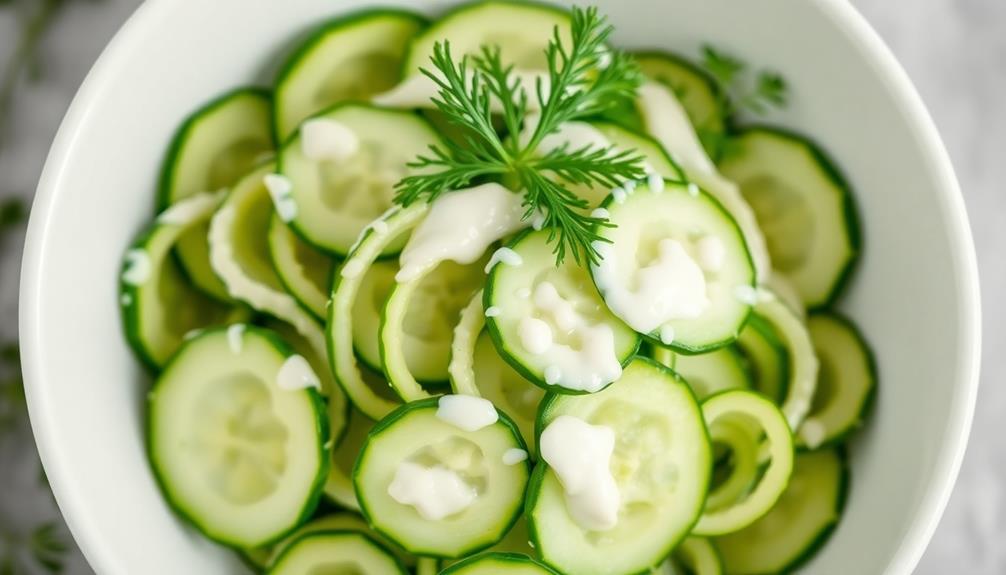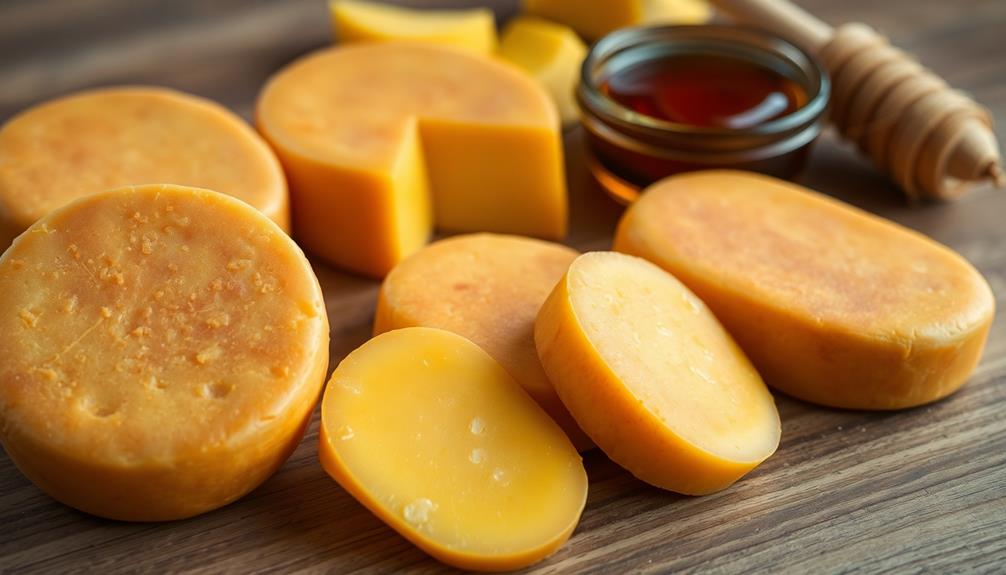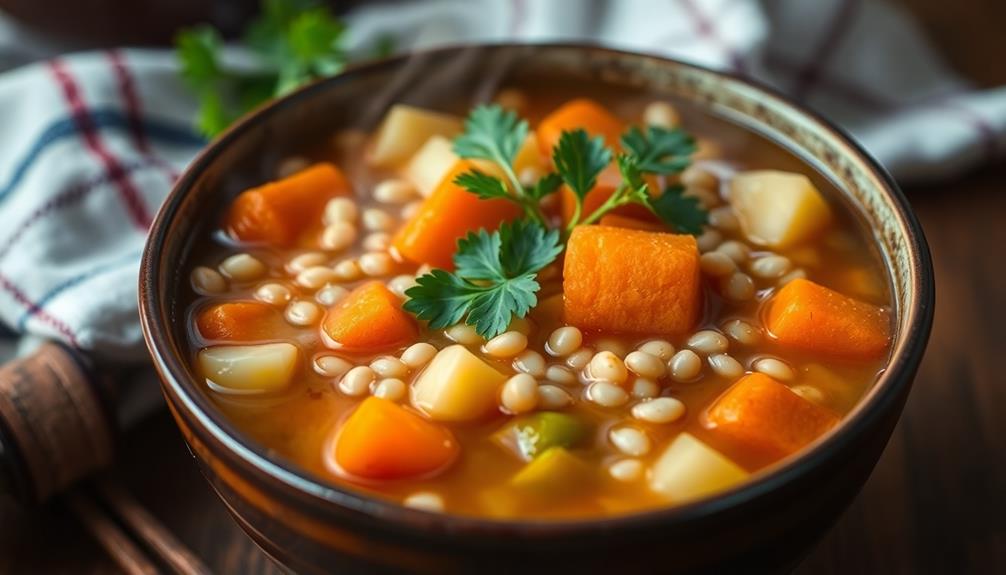Mizeria, the beloved Polish cucumber salad, is a cool and crunchy delight you'll crave on a hot summer day. It features crisp cucumbers dressed in a tangy, creamy mixture infused with fragrant dill and parsley. The refreshing vinegar marinade balances the rich sour cream, while a touch of sugar adds just the right amount of sweetness. Pair it with grilled meats, or enjoy it on its own for a light, healthy snack. The simple preparation and make-ahead convenience make mizeria a versatile choice that'll have you daydreaming about your next refreshing bite. Discover why this classic Polish dish has stood the test of time.
Key Takeaways
- Mizeria is the Polish version of cucumber salad, a refreshing dish with origins tracing back to ancient civilizations.
- The core components of mizeria include thinly sliced cucumbers, sour cream-based dressing, and fresh herbs like dill and parsley.
- Mizeria evolved to incorporate local tastes and ingredients, such as the inclusion of thinly sliced onions in the Polish variation.
- Serving mizeria as a side dish or standalone snack provides a light and healthy option suitable for various dietary preferences.
- Customizing the recipe with additional ingredients like tomatoes or bell peppers allows for further flavor exploration and personalization.
History
Cucumber salad's origins can be traced back to ancient civilizations, where it was enjoyed as a refreshing and nutritious dish. From the Egyptians to the Greeks, this simple yet flavorful combination of fresh cucumbers, herbs, and a light dressing has been delighting palates for centuries.
As trade routes expanded, the recipe spread throughout Europe, evolving to suit local tastes and ingredients. In Poland, it's known as "mizeria," while in other parts of the world, it takes on different names like "tsatsiki" or "raita."
No matter the moniker, the core components remain the same – crisp, cool cucumbers married with aromatic seasonings and a creamy, tangy dressing.
Today, cucumber salad continues to be a beloved summertime staple, offering a bright and healthful contrast to heartier main courses. Its popularity has even transcended geographical boundaries, becoming a globally recognized and cherished dish. For those looking to switch things up, consider blending cucumbers into a refreshing summer soup recipe. This chilled soup is perfect for hot days and can be customized with herbs and other vegetables for a unique twist. Whether enjoyed as a salad or in soup form, cucumbers remain a delicious and versatile addition to any summer menu.
Whether served as a side or a refreshing standalone, this timeless classic remains a testament to the enduring appeal of simple, natural flavors.
Recipe
Cucumber Salad is a refreshing and crisp side dish that can be enjoyed year-round. This simple recipe features the natural sweetness and crunch of cucumbers, complemented by a tangy dressing and aromatic herbs.
The key to a successful cucumber salad lies in the careful selection and preparation of the main ingredient. Choosing fresh, firm cucumbers with a vibrant green hue ensures the salad has a satisfying texture and flavor.
Additionally, taking the time to properly slice or dice the cucumbers can make a significant difference in the overall presentation and mouthfeel of the dish.
- 3 medium-sized cucumbers, peeled and thinly sliced
- 1/2 cup sour cream
- 2 tablespoons white vinegar
- 1 teaspoon granulated sugar
- 1/2 teaspoon salt
- 1/4 teaspoon black pepper
- 2 tablespoons chopped fresh dill (or 1 teaspoon dried dill)
- 1 tablespoon chopped fresh parsley
In a large bowl, combine the sliced cucumbers. In a separate small bowl, whisk together the sour cream, vinegar, sugar, salt, and black pepper until well combined.
Pour the dressing over the cucumbers and toss gently to coat. Sprinkle the chopped dill and parsley over the top, and mix until evenly distributed.
For best results, chill the cucumber salad in the refrigerator for at least 30 minutes before serving to allow the flavors to meld.
The salad can be prepared a day in advance, making it a convenient option for gatherings or meal planning. Enjoy the refreshing and flavorful cucumber salad as a side dish or a light, healthy snack.
Cooking Steps
Grab your knife and start slicing those cucumbers into thin, even rounds.
Next, pour in some tangy vinegar to add a zesty kick.
Don't forget the onions – toss 'em in if you'd like a little extra flavor.
Step 1. Slice Cucumbers Into Thin Rounds
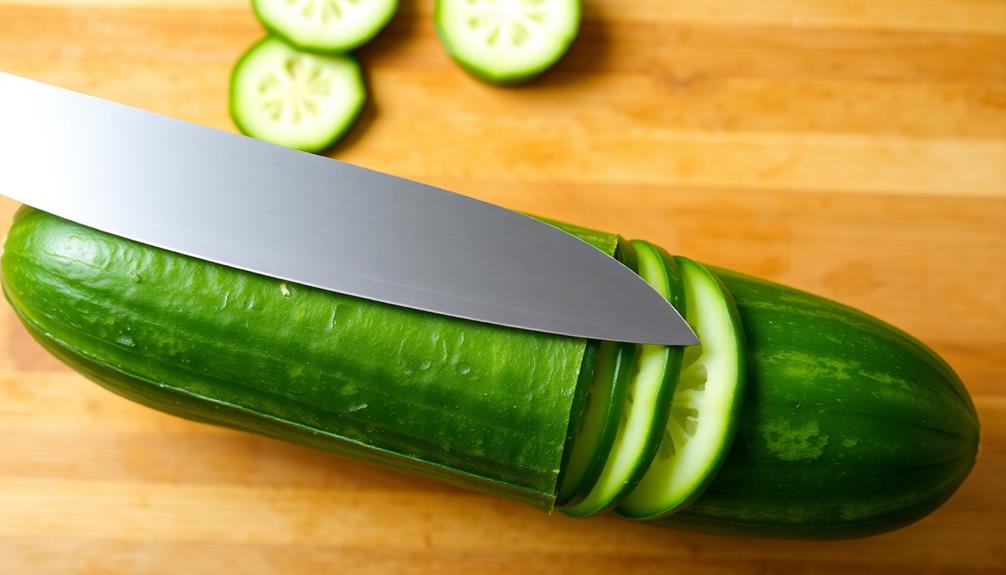
How do you go about slicing the cucumbers into thin rounds? First, grab a sharp chef's knife and a clean, sturdy cutting board. Rinse the cucumbers under cool water and pat them dry with a clean kitchen towel.
Place a cucumber on the cutting board and hold it steady with one hand. Using your other hand, carefully position the knife at the top of the cucumber and start slicing downward, applying gentle pressure to create thin, even rounds.
Work your way down the length of the cucumber, maintaining a consistent slice thickness, typically around 1/4 inch. You may need to adjust your grip and angle the knife slightly to produce the perfect thin, round slices.
As you work, arrange the sliced cucumbers on a plate or in a bowl, ready to be dressed and tossed with the other salad ingredients. Slicing the cucumbers into thin, uniform rounds is the key to creating a visually appealing and texturally pleasing cucumber salad.
Step 2. Add Vinegar

Next, add a splash of vinegar to the sliced cucumbers. This tangy liquid will help balance the cucumber's natural crispness and mild flavor. As you pour the vinegar over the cucumber rounds, watch as it glistens and coats each piece.
The vinegar's sharp, slightly sour notes will brighten up the salad, creating a refreshing contrast to the cool, watery texture of the cucumbers.
Gently toss the cucumbers to ensure the vinegar is evenly distributed. You'll notice the cucumber slices start to take on a slightly pickled appearance as the vinegar penetrates the flesh.
This process not only enhances the flavor but also helps the cucumbers retain their crunchy bite, even as they sit in the dressing. Be sure to add just enough vinegar to lightly coat the cucumbers without drowning them.
The goal is a balanced, tangy-yet-refreshing salad that complements the main dish perfectly.
Step 3. Add Onions, if Desired
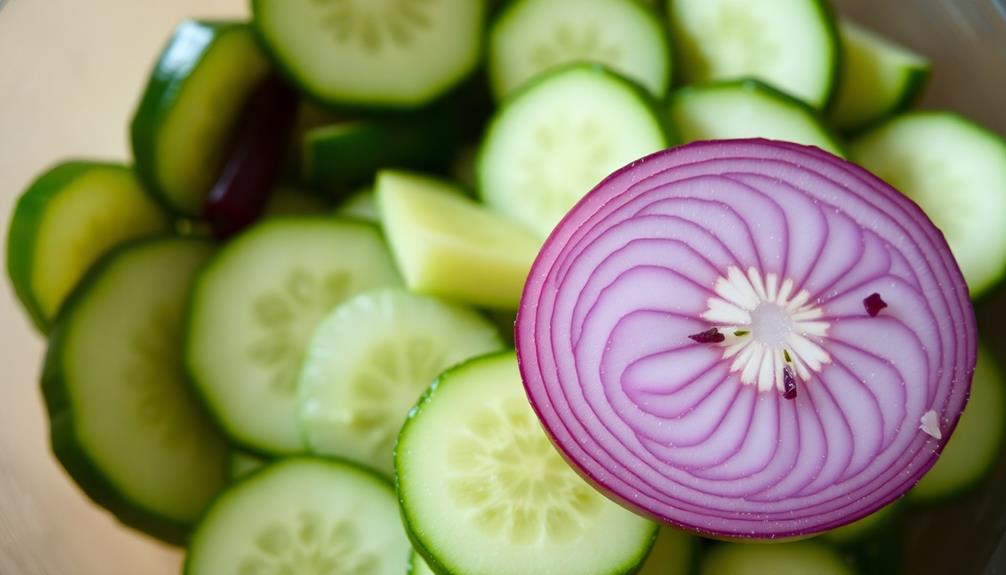
Adding some thinly sliced onions can further enhance the flavor profile of the cucumber salad, if you desire. The crisp, crunchy texture and slightly pungent taste of onions pair beautifully with the cool, refreshing cucumbers.
Simply slice a small onion into thin, even rounds or half-moons, then gently fold them into the salad. The onions will infuse the entire dish with their aromatic essence, creating a delightful contrast to the mild cucumber flavor. Incorporating sensory-rich ingredients like onions can also stimulate a child's sensory processing skills, making mealtime an engaging experience.
You can explore various options for enhancing the dish, similar to how educational toys support cognitive development.
You can experiment with different onion varieties, such as red, white, or sweet onions, to find the one that best suits your taste preferences. Start with a small amount of onion, about 1/4 cup per serving, and adjust the quantity to your liking.
The onions will add a burst of flavor and visual appeal to your cucumber salad. Feel free to customize the ratio of onions to cucumbers to achieve your desired flavor balance.
Step 4. Add Seasoning

With the onions incorporated, it's time to add seasonings that will elevate the flavors of your cucumber salad.
Start by sprinkling in a teaspoon of salt. This will help draw out moisture from the cucumbers, resulting in a crisper texture. Next, add a quarter teaspoon of freshly ground black pepper. The peppery kick will create a nice balance against the cool, refreshing cucumbers.
For a touch of tanginess, stir in a tablespoon of white vinegar or lemon juice. This will brighten up the salad and complement the other flavors.
If you'd like to add an herbal note, finely chop a tablespoon of fresh dill or parsley and fold it in. The fragrant herbs will infuse the salad with a lovely aroma and flavor.
Lastly, give the salad a gentle toss to ensure the seasonings are evenly distributed.
Taste and adjust any seasonings to your preference. With the perfect blend of salt, pepper, and tangy notes, your cucumber salad is now ready to be chilled and enjoyed.
Step 5. Let Stand for 30 Minutes
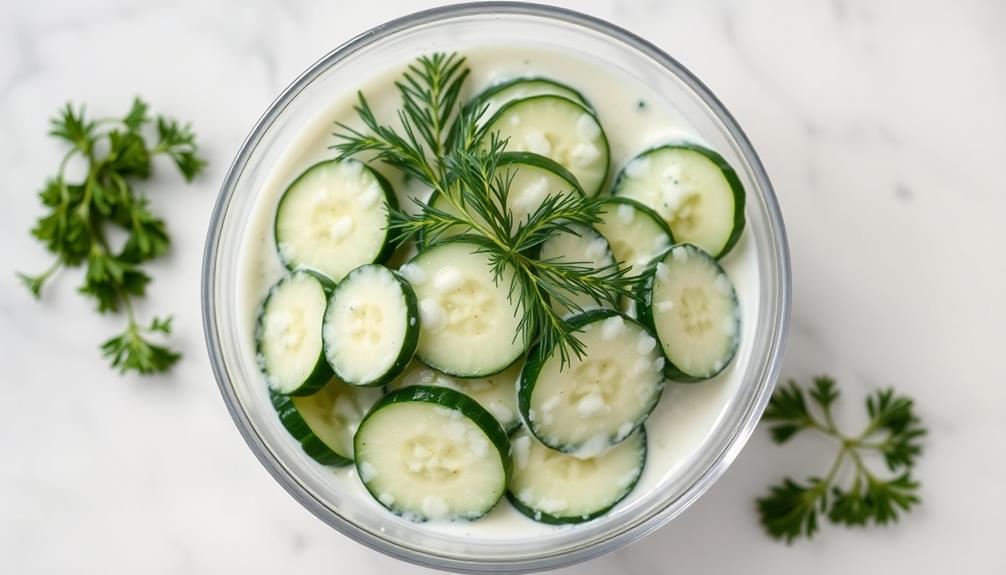
After seasoning the salad, allow it to stand for 30 minutes. This resting period is crucial, as it allows the flavors to meld and the cucumbers to release their juices.
As the salad stands, the seasonings will infuse the vegetables, resulting in a more harmonious and flavorful dish.
During this time, you can take a moment to set the table or prepare any accompaniments. The salad will benefit from this brief pause, becoming even more delightful.
When the 30 minutes have passed, give the salad a gentle stir to ensure all the ingredients are evenly coated. You'll be rewarded with a refreshing and perfectly seasoned cucumber salad, ready to be enjoyed.
The waiting may seem like an eternity, but trust the process. This simple step enhances the overall experience, transforming a basic salad into a true delight for the senses.
Savor the anticipation, for the payoff will be well worth it.
Final Thoughts
Finally, cucumber salad is a refreshing and versatile dish that can be enjoyed throughout the year. Whether you're hosting a backyard barbecue or looking for a light and healthy side, this simple salad is the perfect choice. The cool, crunchy cucumbers paired with the tangy dressing create a delightful balance of flavors that will leave your taste buds wanting more.
One of the best things about cucumber salad is its versatility. You can customize the recipe to suit your personal preferences, adding in your favorite herbs, spices, or even some diced onions or tomatoes.
And because it's so easy to make, it's a great option for busy weeknights or last-minute gatherings.
As you savor each bite, you'll be transported to a summer day, with the sun shining and the breeze gently blowing. Cucumber salad is the perfect way to celebrate the season and enjoy the simple pleasures of fresh, seasonal produce.
Frequently Asked Questions
How Long Can Mizeria Be Stored in the Refrigerator?
You can store your homemade mizeria, or cucumber salad, in the refrigerator for up to 5 days.
Just make sure to keep it in an airtight container. The cool temperature will help the crisp, refreshing flavors last.
After a few days, the cucumbers may get a bit soggy, but it'll still be tasty.
Enjoy your mizeria chilled for a light and healthy side dish or snack anytime!
Can Mizeria Be Made With Different Types of Cucumbers?
Absolutely! You can make this delightful salad with all sorts of cucumbers.
From the classic slicing varieties to smaller Persian or English cucumbers, they'll all work beautifully. The key is to slice them thinly so they soak up the tangy dressing.
Experiment with different textures and flavors to find your perfect combo. Who knows, you might discover a new favorite type of cucumber you've never tried before.
The possibilities are endless – get creative and have fun with it!
Is Mizeria a Traditional Dish in Other Eastern European Countries?
Absolutely! Mizeria, or cucumber salad, is a traditional dish enjoyed throughout Eastern Europe.
While the basic ingredients – cucumbers, sour cream, and dill – remain the same, the recipe can vary slightly from country to country.
For instance, Poles may add a touch of vinegar, while Ukrainians might incorporate a bit of garlic.
No matter the variation, this refreshing side dish is a beloved staple in many Eastern European homes and restaurants.
Why not try making your own twist on this classic recipe?
Can Mizeria Be Served as a Main Dish or Side Dish?
Mizeria can definitely be served as either a main dish or a side! It's incredibly versatile.
As a side, it makes a refreshing accompaniment to heavier main courses, like grilled meats or hearty stews.
But it can also shine as the star of the meal – just pair it with some crusty bread and you've got a delightful, light, and healthy main dish.
The cool, creamy texture and bright flavors of mizeria are sure to please no matter how you choose to enjoy it.
How Can the Creaminess of Mizeria Be Adjusted?
You can easily adjust the creaminess of your dish by playing with the amount of sour cream or yogurt you use.
Start with a smaller quantity, maybe 1/4 cup, and gradually increase it until you reach your desired level of richness.
You can also try substituting some of the sour cream with plain Greek yogurt for a tangier, lighter texture.
Don't be afraid to experiment – the perfect creaminess is all about finding the balance that suits your tastes!
